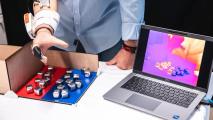Spend even a few minutes online reading about “biohacking,” and you’ll quickly find the magnet people. Perhaps in a story like this one, from The Verge :
Tim, the proprietor of Hot Rod Piercing in downtown Pittsburgh, put down the scalpel and picked up an instrument called an elevator, which he used to separate the flesh inside in Sarver’s finger, creating a small empty pocket of space. Then, with practiced hands, he slid a tiny rare earth metal inside the open wound, the width of a pencil eraser and thinner than a dime. When he tried to remove his tool, however, the metal disc stuck to the tweezers. “Let’s try this again,” Tim said.
“Almost done.”
The implant stayed put the second time. Tim quickly stitched the cut shut, and cleaned off the blood. “Want to try it out?” he asked Sarver, who nodded with excitement. Tim dangled the needle from a string of suture next to Sarver’s finger, closer and closer, until suddenly, it jumped through the air and stuck to his flesh, attracted by the magnetic pull of the mineral implant.
You can find instructions and user reports for magnet implants in pretty much any hardcore biohacking forum. And it’s popular because it provides an inexpensive and simple (if painful) way to give yourself a sixth sense. (According to io9’s guide, implant recipients are able detect “magnetic fields, pick up tiny metal objects, and determine whether metals are ferrous.”)
I read about the magnet people a few years ago, and thought of them again after watching this week’s Superhuman episode on OpenBCI, which makes an inexpensive, 3D-printed headset that allows users to track and then integrate their own brain activity with various hardwares and softwares.
Using the OpenBCI headset doesn’t require a surgical procedure; you just put it on, like a hat. But it has the same philosophical heritage as a slew of other evolving tech trends, magnet implants included. Namely, these “biohacks” offer a way for regular people in non-laboratory settings to understand and alter their own bodies in a way they couldn’t a generation ago.
Biohacking has expanded way beyond high tech
If we define biohacking as self-experimentation with the goal of optimizing performance, then pretty much everyone has done it. Dave Asprey, a leading biohacking evangelist and the inventor of Bulletproof Coffee, posits that something as seemingly simple as improving your diet is a form of biohacking. And he’s not alone in marketing the field that way: biohacking language and concepts are used to describe a lot of low-tech activities, including yoga, meditation, and even illicit drug use.
Biohacking language and concepts are used to describe a lot of low-tech activities, including yoga, meditation, and even illicit drug use.
Journalist Erin Beresini recently made the case in Outside that many of the ideas found in self-help literature just a decade ago are now packaged as biohacking. But that doesn’t mean biohacking as a philosophical framework is the wrong way to think about your body, particularly if dressing basic health and wellness concepts in Silicon Valley garb helped people take better care of themselves.
You can get started with biohacking using consumer tech
If getting empirical about your own body appeals to you, there are ways to play around with biohacking at every price point:
#1 For the best wearable tech–devices that measure your steps, heart rate, and how well you sleep–check out CNET’s recent roundup of the best wearables of 2016.
#2 For iPhone apps that help you track your food intake–like MyFitnessPal–check out Healthline’s list of best diet apps.
#3 For the best of both, check out PCWorld’s roundup of overall best fitness apps.
#4 To see Asprey’s list of the best biohacking apps, go here.
#5 And if you’re looking to do something way more high-tech, obviously you should check out OpenBCI’s headset
And even if you don’t want to get into biohacking yourself, you should still check out our episode on OpenBCI. What they’re doing is amazing.
Feature and homepage image from Charis Tsevis




